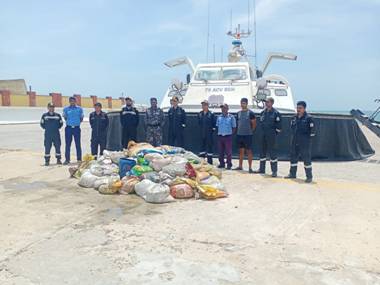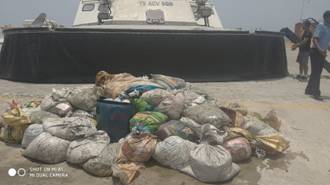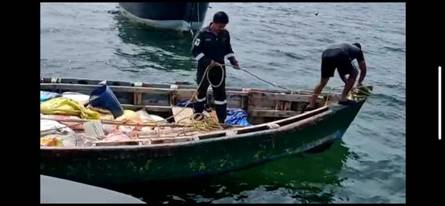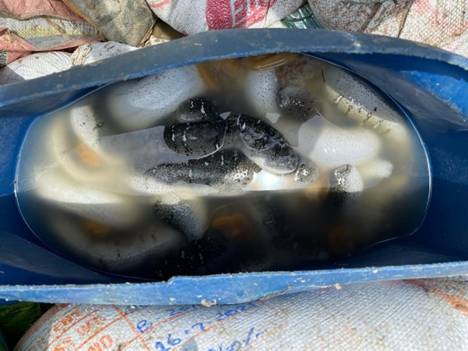Hong Kong – East Coast Park Precinct (Phase 1) in Fortress Hill to officially open this Saturday (with photos)
East Coast Park Precinct (Phase 1) in Fortress Hill to officially open this Saturday (with photos)
******************************************************************************************
The East Coast Park Precinct (Phase 1), located at the harbourfront in Fortress Hill on Hong Kong Island, will be officially opened this Saturday (September 25).
Phase 1 of the Precinct, with an area of about 9 800 square metres, is located to the west of Watson Road. It was previously a works area for the Central-Wan Chai Bypass (CWB) project. In accordance with the principle of developing the harbourfront in an incremental approach, the Highways Department advanced the release of part of the site for public use even though the remaining works of the adjacent CWB project were still under way. The Precinct is also one of the 13 works projects under the $6.5 billion dedicated funding for harbourfront enhancement.
The Secretary for Development, Mr Michael Wong, said at the opening ceremony of the Precinct this evening (September 23) that he was glad to witness another promenade site opened under the incremental approach. The Precinct provides a new promenade section of about 360 metres alongside Victoria Harbour for the public.
The entrance to the Precinct is underneath the CWB flyover. Adopting the design concept of “Windows”, the architect infused window frames of different sizes into the design of balustrades, outdoor installations and a low kerb, offering a distinctive scene for visitors as if it is being viewed through a window. A lawn area, benches, shelters and more are also provided for public use. In addition, to help children play freely while their parents are enjoying the spectacular view of Victoria Harbour, there is painting on the ground for riders of balance bikes, while the architect has introduced slides and safety floor mats at part of the sloping seawall above the sea level in the Precinct, utilising the special characteristics of the site. The Precinct is also a pet-friendly site where pet owners and their pets on leashes are welcome to visit. It will be open to the public around the clock.
One major feature of the Precinct is that it provides the first breakwater officially open to the public within Victoria Harbour. The breakwater is approximately 100m in length, allowing members of the public to enjoy the stunning shoreline of Hong Kong from a new angle at the inner Victoria Harbour. Visitors can also take in a nearly 360-degree panoramic view of Victoria Harbour from the end of the breakwater. The CWB East Vent Shaft above the breakwater was designed specifically to be in harmony with the harbour vista and was the winning entry of an exterior design competition.
In addition, the first large-scale word art installation designed under the theme of Victoria Harbour is also being exhibited in the Precinct. In order to encourage more stakeholders and art groups to participate in harbourfront development, the Development Bureau and the Harbourfront Commission organised the Victoria Harbour Word Art Competition from July to September last year. The winning entry, “The Beacon of Hong Kong”, designed by Arnold Wong and Charmaine Lin, is being displayed at the Precinct. Through its illuminating colourful fonts and Chinese characters of the names of different districts in Hong Kong as well as mesh design, the word art installation celebrates the vibrant life of Victoria Harbour. The hollow design of the individual letters aims to encourage the public to walk inside and become part of the art piece. The public can view the installation from the sea and enjoy the scenery of the Victoria Harbour waterfront from another angle.
Various local green fashion brands designed a series of clothing and accessories for the harbourfront, and collaborated with community members of different ages to conduct a fashion show on the breakwater during the opening ceremony, thereby promoting the harbourfront vision of social inclusion and sustainable development. The clothing from the fashion show will be displayed at the Precinct until October 2.
Design work for the remaining part of the Precinct has already commenced, and the project is aimed at being opened to the public in phases from 2024 in tandem with the Boardwalk underneath the Island Eastern Corridor project.
Mr Wong added, “The Government will continue to take forward the vision of the incremental approach and open more harbourfront spaces for early public enjoyment while various major works projects at the harbourfront are still under way. It is expected that by the end of 2021, the Pierside Precinct (Phase 2), the Water Sports and Recreation Precinct (Phase 2) and the Revitalised Typhoon Shelter Precinct will be open, further extending the existing public promenade alongside Victoria Harbour to 25 kilometres.”
Phase 1 of the Precinct is located to the west of Watson Road. It can be reached from Fortress Hill MTR Station by walking along Oil Street and Electric Road, and then going to the end of Watson Road, with the walk only taking about seven minutes (see attachment).
The Canadian Coast Guard’s Inshore Rescue Boat (IRB) station in Rankin Inlet, Nunavut completed its fourth season of providing maritime search and rescue services on Tuesday, September 7, 2021. September 22, 2021 Yellowknife, Northwest Territories – The Canadian Coast Guard’s Inshore Rescue Boat (IRB) station in Rankin Inlet, Nunavut completed its fourth season of providing maritime search and rescue services on Tuesday, September 7, 2021. In the North, the IRB program is operated by Indigenous post-secondary students, trained by the Canadian Coast Guard. The Rankin Inlet station opened in June 2018 to improve marine safety in Arctic waters in collaboration with Indigenous communities. This year, the station opened on June 23, and provided essential search and rescue services during the summer boating season. During operations in Rankin Inlet, crews participated in training, including medical emergency response, seafaring, towing, and developing skills in rough water vessel handling. They also participated in virtual Inuit Qaujimajatuqangit (Inuit Traditional Knowledge) information sessions led by the Canadian Coast Guard’s Community Engagement Coordinators from various communities across the North. Crews increased their local knowledge by participating in Inuktitut language training sessions and by learning local place names, including islands, inlets, and points of land. These Inuktitut names were added to Coast Guard charts and GPS devices on the vessels. Throughout this season, the IRB crew carried out four training exercises, responded to three SAR cases, and travelled over 854.3 nautical miles. In Rankin Inlet, the IRB crew is an important part of the emergency response system, and works closely with the Canadian Coast Guard Auxiliary, Inuit communities, and other northern organizations to increase maritime safety in the Arctic. Continuing to provide services throughout the duration of the COVID-19 pandemic, the adaptability of the IRB crews ensured Coast Guard continued delivering 24/7 search and rescue services to the Nunavut communities of Rankin Inlet, Chesterfield Inlet, and Whale Cove. The Coast Guard employs post-secondary students from coast to coast to coast through the IRB program to provide supplementary maritime search and rescue services during the busy summer boating season. Marine emergencies can be called into the Joint Rescue Coordination Centre in Trenton 24 hours a day, 365 days a year, at 1-800-267-7270 Media RelationsCanada – Canadian Coast Guard Inshore Rescue Boat North Finishes Summer Season
Fisheries, Oceans and the Canadian Coast Guard Arctic Region
204-984-4715
XCA.Media@dfo-mpo.gc.caCOAST GUARD SEIZES 2000 KG SEA CUCUMBER
In a swift operation, the Indian Coast Guard (ICG) team at Mandapam, Tamilnadu seized two tonnes of sea cucumber, a banned marine species. Working on a tip-off about illegal transhipment of sea cucumber in the wee hours of 19 Sep, the ICG team swung into action and tracked the suspect boat involved in likely smuggling. ICG teams were deployed in Gulf of Mannar and Palk Bay areas to effectively cordon the likely escape by sea route.

Subsequently, the boat was found anchored about 15 kms off Vedalai South of Mandapam without its crew at 10.30 am on Sunday and boarded by team of Coast Guard. The boarding team of ICG Hovercraft H-183 recovered 200 gunny bags of sea cucumber weighing 2000 kg. The boat alongwith seized sea cucumbers was brought to Mandapam near Rameshwaram, Tamilnadu and handed over to forest Officials. The value of seized sea cucumbers is reported to be about 8 Crores INR.

On investigation, it was revealed that the consignment was planned for transhipment across the International Maritime Boundary Line during dark hours. Sea cucumbers are in high demand in China and Southeast Asia. It may be recalled that earlier in the month of July, Coast Guard team at Mandapam had seized about 1200 kg of sea cucumber and apprehended two personnel.


Sea cucumber in India is treated as an endangered species listed under schedule I of Wildlife Protection Act of 1972. It is primarily smuggled from Tamil Nadu to Sri Lanka in fishing vessels from Ramanathapuram and Tuticorin districts.
ABB/DK
(Release ID: 1756319)
Visitor Counter : 369

